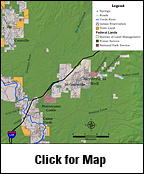Montezuma Well
Introduction
 Montezuma Well is a quiet but spectacular example of a large, limnocrene (pool-forming) spring. It is one of the best-studied springs ecosystems in the world, thanks in large measure to the dedicated research of Dr. Dean W. Blinn and his students at Northern Arizona University. One of the few large limnocrene springs on the Colorado Plateau, it likely contains the highest concentration of endemic (unique) species of any single spring in North America. Ecosystem studies in the Well have helped us understand the evolution of unique species. Located just off Interstate 17 near McGuireville, and part of Montezuma Castle National Monument, the Well and Montezuma Castle preserve extraordinary examples of prehistoric Sinagua cliff dwelling sites.
Montezuma Well is a quiet but spectacular example of a large, limnocrene (pool-forming) spring. It is one of the best-studied springs ecosystems in the world, thanks in large measure to the dedicated research of Dr. Dean W. Blinn and his students at Northern Arizona University. One of the few large limnocrene springs on the Colorado Plateau, it likely contains the highest concentration of endemic (unique) species of any single spring in North America. Ecosystem studies in the Well have helped us understand the evolution of unique species. Located just off Interstate 17 near McGuireville, and part of Montezuma Castle National Monument, the Well and Montezuma Castle preserve extraordinary examples of prehistoric Sinagua cliff dwelling sites.
Geomorphology and Hydrology
Montezuma Well—a collapsed carbonate caldron 368 feet across and 55 feet deep—lies at 3,618 feet elevation in the Verde Valley. Its waters likely are derived from the southern Colorado Plateau just to the north, and undoubtedly have a lengthy and circuitous flow path. The springs well up from the bottom of a collapsed limestone sink and discharge through a natural tunnel at a rate of about 1,100 gallons per minute into Wet Beaver Creek, a tributary of the Verde River. The Well’s water is relatively constant in temperature, varying from 64 degrees to 77 degrees F, with relatively little dissolved oxygen but a high concentration of dissolved carbon dioxide and relatively high concentration of arsenic. The Well has existed at least through the Holocene Epoch (12,000 years) and likely much longer. As an evolutionary microcosm, the pool is essentially free of flood-related disturbance and seasonal impacts. Despite its harsh water chemistry, it provides a stable, highly productive environment for the life within it. This, it appears, is a formula for endemism.Biology
Montezuma Well is set in the juniper-mesquite shrublands typical of its elevation in the region, well above the floodplain of Wet Beaver Creek. The Well’s pool and outflow tunnel support at least five unique species: an endemic diatom, a springsnail, a water scorpion, an amphipod, and a new genus and species of leech. In addition to unique species, the Well supports several regionally rare aquatic beetles and other insects, including Belostoma bakeri, a tiny member of the giant waterbug family, and a delicate marsh treader.From an ecosystem standpoint, the Well’s vegetation supports a very large population of amphipods that serve as a prey base. By day, Montezuma Well’s predator assemblage is dominated by the small, red, desert firetail damselfly, as well as the water scorpion and giant water bug. By night, a horde of endemic leeches swarms up from the depths. The larval damselflies and waterbugs are visual predators in the dense pondweed vegetation around the pool’s periphery. Leeches spend their days in the ooze at the bottom of the Well, swimming to the surface to feed at night. Both sets of predators feed on the endemic amphipod, which spends the day in moderately deep open water, avoiding direct sunlight and the predators in the peripheral vegetation. The amphipod moves to the outer margins of the weed beds at night to avoid predation by leeches.
Although the water is inhospitable to fish, Montezuma Well supports some vertebrate life. Sonora mud turtles crawl the pond, feeding on leeches and other invertebrates. Various waterfowl species visit the Well, and it is not unusual to see American coots plying the pondweed beds. Prior to their extirpation or extinction, the Well was also visited by Colorado River otter. The type specimen of that otter was taken at this site in the late nineteenth century. Not without human impacts, the Well also supports an introduced population of red-eared slider turtles that is targeted for removal by the National Park Service.
There are several reasons for the high levels of endemism at Montezuma Well. Its location in the Verde Valley is one factor. The Verde River drainage supports a diverse assemblage of aquatic, wetland, and riparian life: there is a great abundance of biological material for nature to test at Montezuma Well. Next is the Well’s protected, highly productive condition. Nearby aquatic habitats like Wet Beaver Creek are much more highly disturbed by flooding and seasonality, conditions that force resident biota toward generalized, rather than specialized, life histories and dispersal strategies. In contrast to its aquatic biota, the surrounding slopes within the Montezuma Well do not support rare or unique terrestrial plant species. Rather, its vegetation resembles what we find throughout the Verde River drainage, probably because the wetland and terrestrial portions of the well’s ecosystem occupy rather steep slopes that have been disturbed by humans for millennia—from Sinagua Indians, to early settlers, to modern ranchers and visitors. The desert slopes in the Well are subject to seasonal temperature variation, torrential rainstorms, and disturbance by large animals—conditions that do not support the evolution of unique taxa. Another factor in the high levels of endemism at Montezuma Well is the presence of arsenic, which augments the already harsh chemical conditions of the Well’s water; however, the role of arsenic in endemism has not been well studied.
Human History
While evidence of Paleoindians in the Verde Valley is scant, archaeological clues to subsequent cultures abound. The Hohokam culture appeared in the area about A.D. 600, living in single-room structures and growing corn and other crops. They were replaced by the Puebloan Sinagua culture after about A.D. 900. Sinagua artifacts in the Beaver Creek drainage include elaborate dwellings, canals, artifacts, and a unique style of rock art between A.D. 900 and 1425. Montezuma Castle, 11 miles south of the Well, is one of the best known and preserved Sinaguan cliff dwelling sites, exceeded only by the ruins at Tuzigoot National Monument. The stately 17-room stone-and-mud Montezuma Castle overlooks elegant sycamore and cottonwood trees along Beaver Creek. The Well and Beaver Creek were used by the Sinagua as irrigation sources; several Sinagua canals still exist and some remain in use today. Many Sinagua artifacts have been recovered, including pottery and jewelry. Their middens (trash heaps) show reliance on corn, beans, squash, century plant, seeds, and even cotton. These food and crop remains indicate that the Sinagua were both farmers and hunter-gatherers.The Well was probably first seen by Europeans during the 1583 Spanish expedition of Antonio de Espejo, who described an abandoned pueblo (likely Montezuma Castle) and a pond (likely Montezuma Well). A railroad survey in the mid-1880s reported abandoned Indian villages in the Verde Valley, but it was Edgar Mearns, a military physician stationed at Fort Verde, who in 1884 was the first scientist to see the site. The Smithsonian Institution took notice of the Well, sending Cosmos Mindeleff in 1892 and Jesse W. Fewkes in 1895 to investigate. By 1930, a total of 185 archaeological sites had been identified in the Verde Valley and surrounding plateau.
Conservation
Concerns over archaeological site pot-hunting and excavation encouraged area residents to propose the area as a national monument. President Theodore Roosevelt proclaimed the Montezuma Castle National Monument on December 8, 1906, including 840 acres on and around Montezuma Well. After passage of the National Park Service Organic Act in 1916, the Monument was transferred to the newly formed National Park Service.Increasingly intense human disruption of aquifers and native ecosystems leaves the future of springs and the narrowly adapted endemic species they support in jeopardy. More than 90 percent of the springs in northern Arizona have been dewatered or are ecologically impaired because of groundwater pumping, development, or modification for livestock or human use. Many non-native species have been introduced and these changes have taken place too quickly to permit adjustment by native biota. Protecting springs from livestock grazing and leaving water flowing from the source area can help retain native species. Improved inventory and understanding which habitats are most threatened also will help land managers and the public make better long-term decisions. Education of the public and managers at places like Montezuma Well is essential if we are to conserve our rich natural heritage for future generations of Arizonans.
Contributing WritersLarry Stevens and Jeri Ledbetter.
Links
Visitation and Conservation
http://www.nps.gov/moca/http://www.desertusa.com/mzm/du_mzm_desc.html
Historical Information
http://beavercreek.nau.edu/Archaeology/archaeology.htmBibliography
- Blinn, D.W. 2008. The extreme environment, trophic structure, and ecosystem dynamics of a large, fishless desert spring: Montezuma Well, Arizona. In Stevens, L.E. and V.J. Meretsky, editors. Every last drop: ecology and conservation of aridlands springs in North America. University of Arizona Press, Tucson, in press.
- Govedich, F.R., D. Blinn, P. Keim, and R.W. Davies. 1998. Phylogenetic relationships of three genera of Erpobdellidae (Hirudinoidea), with a description of a new genus, Motobdella, and species, Motobdella sedonensis. Canadian Journal of Zoology 76: 2164-2171.
- Grand Canyon Wildlands Council, Inc. 2002. A hydrological and biological inventory of springs, seeps and ponds of the Arizona Strip, final report. Arizona Water Protection Fund, Phoenix.
- Runck, C. and D.W. Blinn. 1990. Population dynamics and secondary production by Ranatra montezuma (Heteroptera: Nepidae). Journal of the North American Benthological Society 9:262-270.
- Springer, A.E., L.E. Stevens, and R. Harms. 2006. Inventory and classification of selected National Park Service springs on the Colorado Plateau: NPS Cooperative Agreement Number CA 1200-99-009. National Park Service, Flagstaff.
Species Names:
American coot (Fulica americana)
Colorado River otter (Lontra canadensis sonora)
Desert firetail damselfly (Telebasis salva)
Giant waterbug (Belostoma bakeri)
Marsh treader (Hydrometra aemula)
Montezuma Well diatom (Gomphonema montezumense)
Montezuma Well springsnail (Pyrgulopsis montezumensis)
Montezuma Well water scorpion (Ranatra montezuma)
Montezuma Well amphipod (Hyalella montezuma)
Montezuma Well leech (Motobdella sedonensis)
Red-eared slider (Trachemys scripta)
Sonora mud turtle (Kinosternon sonoriense)






